Okay, so you create a BufferedImage and grab it's Graphics context...
BufferedImage im = new BufferedImage(sizeX, sizeY, BufferedImage.TYPE_4BYTE_ABGR);
Graphics g2 = (Graphics)im.getGraphics();
And do nothing with it...
You then create a second BufferedImage, grab it's Graphics context, set it's rotational context and paint nothing to it...
BufferedImage bufferedImage = new BufferedImage(imageIcon.getIconWidth(), imageIcon.getIconHeight(), BufferedImage.TYPE_4BYTE_ABGR);
Graphics2D g2d = (Graphics2D)bufferedImage.getGraphics();
g2d.rotate(Math.toRadians(degrees), imageIcon.getIconWidth() / 2, imageIcon.getIconHeight() / 2);
You then paint the original image to the supplied Graphics context...
g.drawImage(image, x, y, sizeX, sizeY, null);
Having achieved nothing at all...
I think you need to start by taking a read through Transforming Shapes, Text, and Images to get some grounding on the basics...
Transformations are compounding, they also only effect whatever is painted to the Graphics context AFTER they have been applied.
The simplest approach would actually be to use a AffineTransform
double scaleWidth = (double)sizeX / (double)image.getWidth(this);
double scaleHeight = (double)sizeY / (double)image.getHeight(this);
BufferedImage img = new BufferedImage(sizeX, sizeY, BufferedImage.TYPE_INT_ARGB);
Graphics2D g2d = img.createGraphics();
AffineTransform at = new AffineTransform();
at.scale(scaleWidth, scaleHeight);
at.rotate(Math.toRadians(degrees), image.getWidth(this) / 2d, image.getHeight(this) / 2d);
g2d.setTransform(at);
g2d.drawImage(image, sizeX / 2, sizeY / 2, null);
g2d.dispose();
// And finally, the result...
g.drawImage(img, x, y, null);
For example...

import java.awt.Color;
import java.awt.Dimension;
import java.awt.EventQueue;
import java.awt.Graphics;
import java.awt.Graphics2D;
import java.awt.Image;
import java.awt.geom.AffineTransform;
import java.awt.image.BufferedImage;
import java.io.File;
import java.io.IOException;
import javax.imageio.ImageIO;
import javax.swing.JFrame;
import javax.swing.JPanel;
import javax.swing.UIManager;
import javax.swing.UnsupportedLookAndFeelException;
public class TestImage {
public static void main(String[] args) {
new TestImage();
}
public TestImage() {
EventQueue.invokeLater(new Runnable() {
@Override
public void run() {
try {
UIManager.setLookAndFeel(UIManager.getSystemLookAndFeelClassName());
} catch (ClassNotFoundException | InstantiationException | IllegalAccessException | UnsupportedLookAndFeelException ex) {
ex.printStackTrace();
}
JFrame frame = new JFrame("Testing");
frame.setDefaultCloseOperation(JFrame.EXIT_ON_CLOSE);
frame.add(new TestPane());
frame.pack();
frame.setLocationRelativeTo(null);
frame.setVisible(true);
}
});
}
public class TestPane extends JPanel {
private BufferedImage original;
public TestPane() {
try {
original = ImageIO.read(new File("Your image here"));
} catch (IOException ex) {
ex.printStackTrace();
}
}
@Override
public Dimension getPreferredSize() {
return new Dimension(200, 200);
}
public Image scaleAndRotate(Image image, int sizeX, int sizeY, double degrees) {
double scaleWidth = (double)sizeX / (double)image.getWidth(this);
double scaleHeight = (double)sizeY / (double)image.getHeight(this);
BufferedImage img = new BufferedImage(sizeX, sizeY, BufferedImage.TYPE_INT_ARGB);
Graphics2D g2d = img.createGraphics();
AffineTransform at = new AffineTransform();
at.scale(scaleWidth, scaleHeight);
at.rotate(Math.toRadians(degrees), image.getWidth(this) / 2d, image.getHeight(this) / 2d);
g2d.setTransform(at);
g2d.drawImage(image, sizeX / 2, sizeY / 2, null);
g2d.dispose();
return img;
}
@Override
protected void paintComponent(Graphics g) {
super.paintComponent(g);
Graphics2D g2d = (Graphics2D) g.create();
int scaleWidth = getWidth() / 2;
int scaleHeight = getHeight() / 2;
Image img = scaleAndRotate(original, scaleWidth, scaleHeight, 45.0);
int x = (getWidth() - img.getWidth(this)) / 2;
int y = (getHeight()- img.getHeight(this)) / 2;
g2d.drawImage(img, x, y, this);
g2d.dispose();
}
}
}
You may also like to take a read through...
For discussions about scaling algorithms and techniques
You should also know that the size of an image when it rotates also changes, have a look at (one of my favourite answers to refer to) Rotate an image in java for more details about how to calculate the resulting image size of a rotated image...
